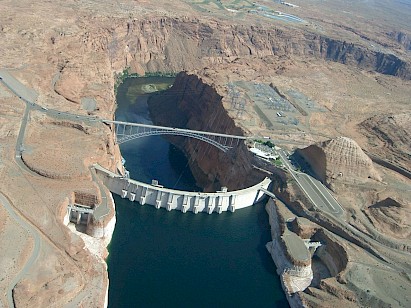Colorado River reservoirs are so low, government is delaying releases
 With long-term severe drought continuing to take a toll on the Colorado River, the federal government is expected to announce on Monday that it will retain some water in one of the river’s major reservoirs to temporarily stave off what it called increased uncertainty in water and electricity supplies.
With long-term severe drought continuing to take a toll on the Colorado River, the federal government is expected to announce on Monday that it will retain some water in one of the river’s major reservoirs to temporarily stave off what it called increased uncertainty in water and electricity supplies.
The anticipated decision to keep more water in Lake Powell on the Arizona-Utah border, rather than releasing it downstream to the other major reservoir, Lake Mead near Las Vegas, comes as both are at record-low levels after 20 years of drought. Powell, behind Glen Canyon Dam, currently holds less than one-fourth of the amount it held when it filled after the dam was built in the 1960s.
In a letter last month to officials of the seven states that receive water from the river, an assistant Interior Department secretary, Tanya Trujillo, said there were concerns that Powell could decline further over the next 24 months to a “critically-low” level at which the dam could no longer generate hydropower. That would create a number of problems for the water and electricity supply and for the dam itself, she wrote.
In a joint letter two weeks later, the state officials agreed to the proposal to keep more water in the lake “to reduce the risks we all face.”
The decision would keep nearly half a million acre-feet of water in Lake Powell. That is about 8 percent of the lake’s current volume, and is equivalent to the annual amount used by a million or more households. Under a separate plan agreed to last month, the bureau will also release a half million additional acre-feet into Powell from an upstream reservoir, Flaming Gorge, at the Utah-Wyoming border.
Without the additional water, the bureau had estimated there was about a one in four chance that by 2024 the lake level would fall below 3,490 feet above sea level, at which point power could no longer be produced.
Conservationists and water policy experts said the expected decision was only a short-term fix, and that work must be done quickly on ways to make the river, which supplies water to 40 million people, as well as for agricultural and industrial use, sustainable over the long term.
Bart Miller, a program director with Western Resource Advocates, an environmental advocacy group, said his organization supported the bureau’s decision. “But it’s not enough to fix the problem,” he said. “Throughout the Colorado River basin we are using more water than the river provides.”
Haley Paul, policy director at Audubon Arizona, said that the region needed to figure out how to share a river made smaller by climate change. “I don’t think we’re there and we urgently need to get there,” she said.
The bureau is evaluating the situation and could decide this summer that Lake Mead has declined to a point where even more cuts are necessary. But in response to a request from the officials in the seven states, the bureau is expected to say that it won’t take into account the water held back from Mead in making its decision.
The reservoirs, the two largest in the United States, have been declining for years, amid a megadrought that began in 2000 and that has continued and been made worse by global warming. This period is now the driest two decades in 1,200 years.
The Colorado gets most of its water from melting snowpack, and the situation has worsened over the past two years as soils have become so dry that much of the runoff was absorbed before reaching the river. This year, runoff in the upper Colorado basin, which reaches Lake Powell, is projected to be only about two-thirds of average.
The level of Lake Powell is currently at an elevation of 3,523 feet, 177 feet below capacity. The intakes that allow water through the dam to generate hydropower are at 3,490 feet.
Hydropower is useful in maintaining the stability of electrical grids in part because the amount of electricity generated can quickly be changed to help the grid match demand. In her letter, Ms. Trujillo said that if Powell reached 3,490 feet, “the western electrical grid would experience uncertain risk and instability.”
In addition, she wrote, water supplies to Western and Southwestern states “would be subject to increased operational uncertainty.” Water supplies to Page, Ariz., near the dam, and a nearby Native tribe, would especially be at risk, she wrote, because their intake is at about the same elevation as the hydropower intakes.
The dam itself would face “unprecedented reliability challenges,” Ms. Trujillo wrote, because with the hydropower intakes above the water level, the lake water would have to be routed through the dam using lower tunnels that were not designed for continuous use. “We are approaching operating conditions for which we have only very limited actual operating experience — and which occurred nearly 60 years ago,” she wrote.
Brad Udall, a senior climate scientist at Colorado State University, said the concerns in the letter about the reliability of the power grid and of the dam had not really been raised in all the drought contingency planning over the past few decades.
“We’ve expended a lot of effort in producing plans” for what happens when the reservoirs fall to critical levels, Mr. Udall said. “And what we’re finding out, unfortunately, is that these plans are turning out to be completely inadequate. All of a sudden these new issues arise and haven’t having previously been considered and are really important.”
You can return to the main Market News page, or press the Back button on your browser.

